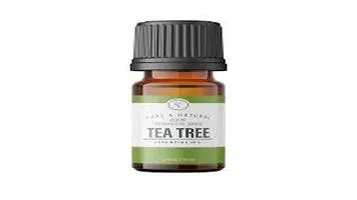Tea Tree Oil: A Comprehensive Review
Tea Tree Oil, derived from the leaves of the Melaleuca alternifolia plant native to Australia, is renowned for its potent antiseptic and anti-inflammatory properties. This essential oil has a fresh, medicinal aroma and a pale yellow color. Historically used by Indigenous Australians for its healing abilities, Tea Tree Oil is now widely incorporated into skincare and haircare products due to its ability to combat acne, soothe irritated skin, and treat dandruff. Its natural antibacterial and antifungal characteristics make it an effective remedy for minor cuts, insect bites, and fungal infections. However, it should be used with caution, as it can cause irritation if applied undiluted. Always perform a patch test before full application and consult with a healthcare professional for proper usage.

Tea Tree Oil, derived from the leaves of the Melaleuca alternifolia plant native to Australia, has long been celebrated for its myriad of therapeutic properties. Known for its antiseptic, anti-inflammatory, and antimicrobial benefits, tea tree oil has carved out a significant niche in both traditional and modern medicine. This review aims to delve deep into the attributes, applications, and potential drawbacks of this versatile essential oil.
Historical Context and Extraction
Historically, Indigenous Australians have used tea tree leaves to treat coughs and colds, heal wounds, and alleviate skin conditions. The oil is extracted through steam distillation of the leaves, a process that ensures the preservation of its potent compounds, primarily terpinen-4-ol, which is responsible for most of its antimicrobial activities.
Therapeutic Properties
1. Antimicrobial and Antiseptic Properties:
Tea tree oil is renowned for its antimicrobial properties. It is effective against a variety of pathogens including bacteria, viruses, and fungi. Studies have shown its efficacy in treating acne, thanks to its ability to combat the bacteria Propionibacterium acnes. It’s also a popular natural remedy for fungal infections like athlete’s foot and toenail fungus.
2. Anti-inflammatory Benefits:
The oil’s anti-inflammatory properties make it beneficial for soothing irritated skin and reducing redness and swelling. This is particularly useful in treating conditions like eczema, psoriasis, and insect bites. When diluted with a carrier oil, tea tree oil can be applied topically to alleviate these symptoms.
3. Wound Healing:
Tea tree oil boosts wound healing by reducing inflammation and increasing the activity of white blood cells, which are integral to the healing process. Its antiseptic nature makes it an excellent choice for treating minor cuts, burns, and abrasions.
4. Oral Health:
Tea tree oil’s antimicrobial properties extend to oral health as well. It can be found in natural toothpaste and mouthwashes, where it helps to combat bad breath and prevent plaque buildup. However, it’s crucial to note that tea tree oil should never be swallowed and should always be used in diluted form when used orally.
Applications in Personal Care
Tea tree oil’s versatility extends to various personal care products. It is commonly found in shampoos, conditioners, and scalp treatments for its ability to combat dandruff and soothe an itchy scalp. Its antifungal properties also make it a key ingredient in foot powders and sprays. Additionally, tea tree oil is an effective natural deodorant, capable of neutralizing body odor without the harsh chemicals found in conventional deodorants.
Household Uses
Beyond personal care, tea tree oil proves useful in household cleaning. Its antimicrobial properties make it an excellent natural disinfectant. When added to water and vinegar, it creates a powerful cleaning solution that can be used on various surfaces around the home. It’s also effective in laundry, helping to kill bacteria and freshen clothes.
Safety and Precautions
While tea tree oil offers numerous benefits, it is essential to use it correctly to avoid potential adverse effects. Pure tea tree oil is highly concentrated and should always be diluted with a carrier oil before topical application. Common carrier oils include coconut oil, jojoba oil, and almond oil. A patch test should be conducted to ensure there is no allergic reaction.
Ingestion of tea tree oil is strongly discouraged due to the risk of toxicity, which can lead to symptoms such as confusion, ataxia (loss of muscle coordination), and even coma. Additionally, tea tree oil should be kept out of reach of children and pets, as it can be harmful if ingested.
Certain individuals, particularly those with sensitive skin or allergies, may experience irritation or allergic reactions. Symptoms can include redness, itching, and burning sensations. In such cases, discontinuing use and consulting a healthcare professional is advised.
Environmental Impact
Tea tree oil is a renewable resource, and its cultivation and harvest have minimal environmental impact when managed sustainably. However, like all natural resources, responsible sourcing and production practices are crucial to ensuring long-term availability without harming the ecosystem.
Conclusion
Tea tree oil is a powerful, multipurpose essential oil with a wide range of applications in both health and household contexts. Its antimicrobial, anti-inflammatory, and antiseptic properties make it a valuable natural remedy for many common ailments and an effective ingredient in personal care and cleaning products. However, its potency requires careful handling and proper dilution to avoid potential side effects.
For those seeking natural alternatives to conventional treatments, tea tree oil offers a compelling option. With its rich history and proven efficacy, it remains a staple in natural medicine cabinets worldwide. As with any natural remedy, it is important to use tea tree oil responsibly and to consult with healthcare professionals when in doubt.






